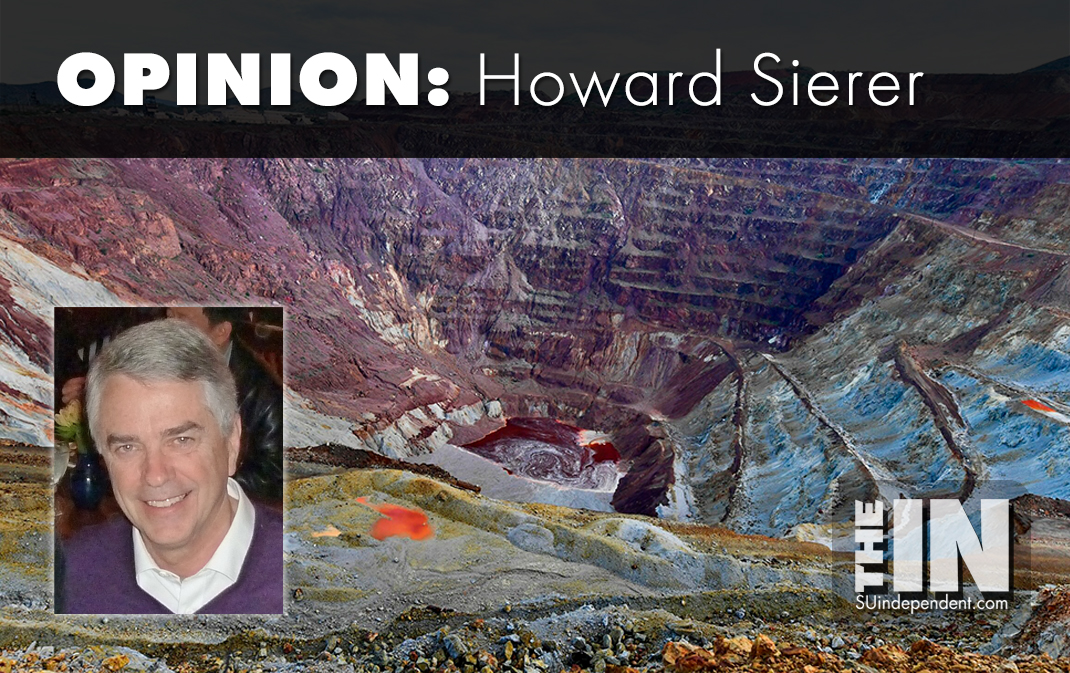
The Dirty Business of Making Clean Energy
– By Howard Sierer –
Lithium can’t be grown on sustainable, organic farms. Nor can cobalt, gallium, or nickel. Each of these minerals is needed in large quantities to produce electric vehicle (EV) batteries, solar panels and wind turbines for what is termed clean energy.
The ores containing them must be dug out of the ground, hauled by truck to processing plants, and refined – usually at very high temperatures – to produce the finished metal. And there’s the rub.
Getting them out of the ground requires equipment – very big equipment and lots of it – powered by fossil fuels. Consider the Caterpillar 994K Large Wheel Loader widely used in strip mining. It burns 900 to 1000 gallons of fuel in a 12-hour shift and its bucket can carry up to 50 cubic yards of ore weighing over 125,000 pounds or 60 tons.
Caterpillar’s largest mining truck is the 798AC with a gross weight of 687 tons when loaded. Depending on the distance to the ore refinery, several dozen trucks could be needed at any strip mine. There are about 52,000 mining trucks active around the world today, each burning hundreds of gallons of fuel each day.
According to projections by the International Energy Agency, achieving global net-zero emissions by 2050 will require expanding the production of energy-relevant metals from 7 million metric tons per year to 42 million by 2040, a dramatic sixfold increase. Demand for lithium is expected to grow by 40 times over 2020 levels as EV sales take off worldwide.
According to the U.S. Geological Survey, global production of lithium in 2021 was 100,000 tons, some from brine operations in China, Argentina, and Chile but 55,000 tons from strip mines in Australia plus more strip mined in China. Using the IEA’s figures, as much as four million tons per year of lithium will be needed by 2040. For every ton of mined lithium, 15 tons of carbon dioxide will be released into the air.
Today China produces 76% of lithium-ion batteries worldwide; the U.S. produces 8%. Congress recognized the strategic importance of reducing our dependence on China in general and for electric vehicle batteries in particular.
Its recent legislation specifies that federal electric vehicle subsidies of up to $7500 will not apply to EVs that use batteries that contain minerals that “were extracted, processed, or recycled by a foreign entity of concern” beginning in 2029. China is the targeted entity of concern.
So, we can expect a lot of pressure to “extract” lithium and the other needed metals in this country. The best prospect for U.S. lithium mining is at remote Thacker Pass in north central Nevada. Lithium concentrations there run from two-tenths to nine-tenths of a percent, requiring from 110 to 500 tons of ore to yield a ton of lithium.
To meet our country’s expected EV requirements, the proposed Thacker Pass mine along with other U.S. sources of lesser size and quality will need to strip mine about 200 million tons of ore annually. To meet global demand, dozens of strip mines will be needed worldwide.
Even more problematic, sulfuric acid in prodigious quantities is required to leach lithium from the clay stone. Hundreds of tons of sulfur waste from oil refineries (roughly 75 semi-truck loads) will be trucked to Thacker Pass and burned every day.
To these near-term environmental concerns, another complicating factor must be faced down the road. When solar panels and wind turbines reach the end of their useful life – usually about 20-30 years – these minerals will need to be recycled into new products, a process with poorly-understood environmental consequences of its own.
Thacker Pass is where the environmental movement’s irresistible force – eliminating fossil fuels – meets its immovable object – preserving the natural environment. In this case, the immovable object is represented by Protect Thacker Pass, an activist environmental group striving to “stop Lithium Americas from physically disturbing Thacker Pass.” Another opponent, Dr. James J. A. Blair of Cal Poly Pomona will lecture on lithium mining at Utah Tech’s Forum on Tuesday, 20 September. Forums are open to all community citizens.
For decades, the environmental movement has been adept at using the courts to prevent or at least stall for years civil projects – highways, dams, airports, etc. – and commercial projects such as mines, factories, pipelines, power plants and transmission lines. After running up project costs with multi-year legal delays, either compromises are reached or projects abandoned. Which will it be at Thacker Pass?
I expect unseemly infighting among environmental activist groups since some will undoubtedly line up on both sides. Groups with more pragmatic perspectives will recognize the need to move quickly to find a compromise that allows the mine to move forward before the 2029 deadline. But an uncompromising Protect Thacker Pass along with others, no matter how small or unrepresentative, could still delay the mine for a decade or more or even kill it completely.
Will Congress and the Biden administration step in to designate Thacker Pass a national priority, preempting environmental objections? Don’t hold your breath: such legislation would be bound to offend a noisy part of the Democratic base.
Thacker Pass will be a bellwether indicating whether the environmental left, faced with compelling reality, is becoming more rational. Defeating a lithium mine in this country would illustrate a narrow-minded “not in my backyard” mentality since alternative lithium mines elsewhere in the world would produce equivalent environmental damage while making our country more vulnerable to supply disruptions.
Moral of this story: most environmental actions require complex tradeoffs, often overlooked or ignored by their proponents. In this case, expect any benefits from electric vehicles for the next 20 years to be swamped out by a massive increase in the dirty business of making clean energy.



